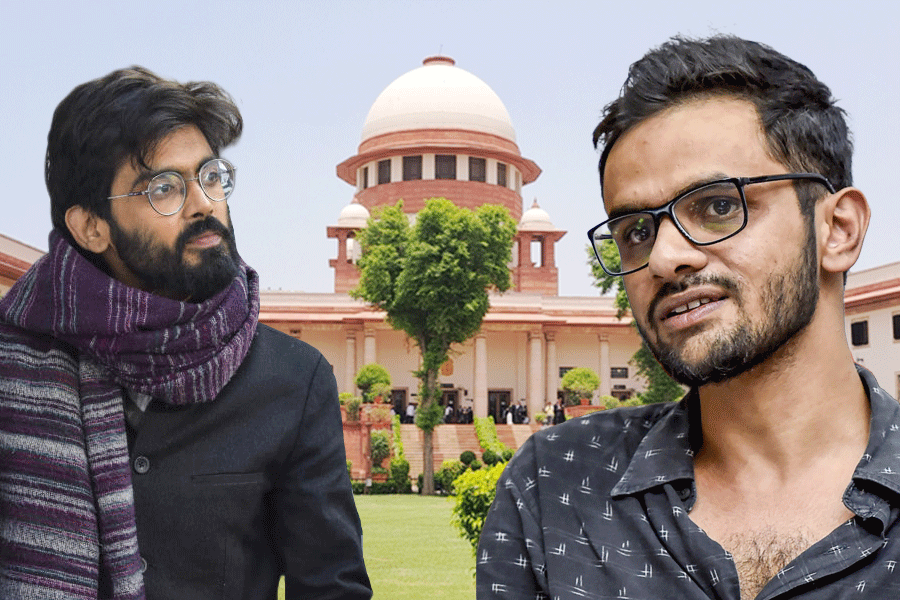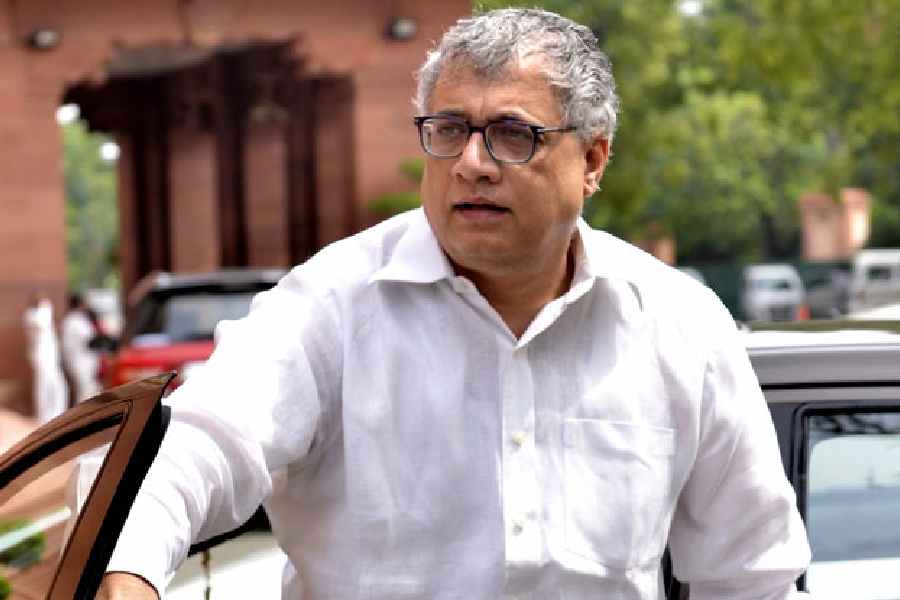When Nandikar revived Football, Rudraprasad Sengupta inserted a line saying everybody worships Rabindranath but nobody reads him — pujo korey, porey na. The alliteration added emphasis to the gulf between practice and precept that was also a glaring feature of this week’s abundance of artistry, consumerism and one-upmanship presented as devotion. The criticism is not of the event but of its scale and style, of squandered resources and the bonanza for the ad men and con men preying on innocents and believers. It highlighted the contradiction between exalting the divine woman power that the Mahishasurmardini incarnation represents and — despite a female chief minister who reportedly rules her male colleagues with an iron hand — indifference to the female condition in the world around us.
I mean the overall climate of inequality and exploitation more than specific abuses that the #MeToo frenzy may expose. The National Crime Records Bureau’s figures for 2016 — the latest available — are especially galling when one recalls that a former West Bengal governor, Shanti Swaroop Dhavan, made powerful enemies by saying he would rather trust his daughter to a taxi at night in Calcutta than in Delhi. Things have changed. With offences falling from 2,353 in 2014 to 1,927 the following year and 1,693 in 2016, Calcutta is no longer India’s capital for crimes against women. But West Bengal makes up for the city’s relegation to second place.
The state leads in domestic violence, accounting for 17.48 per cent of the 1,10,378 recorded cases nationwide. Since 59.36 per cent of these involved cruelty by husbands and in-laws, the trigger was probably dowry: Bengal accounts for more dowry deaths than any other state. Dowry was outlawed as long ago as 1961 but is still virtually mandatory in many circles. Similarly, Bengal leads the country in actual and attempted acid attacks on women. What is even more appalling is that these atrocities are not blamed on bestiality but on factors like the easy availability of acid, loopholes in the Supreme Court’s ban of across-the-counter sales without proof of identity, the absence of especially rigorous sales restrictions in rural and semi-urban areas, and poor policing. Such reasoning suggests that people will remain just as barbaric even if the fear of punishment does succeed in putting an end one day to a gruesome practice. The NCRB figures also show that Bengal, supposed spearhead of the mission civilisatrice that dragged India from medievalism to what passes for modernity, isn’t lagging behind in gang rape either.
Gopal Krishna Gokhale would have been horrified to learn that far from illumining the path forward, Bengal is in the same boat as Uttar Pradesh, Rajasthan, Madhya Pradesh and Haryana when it comes to social behaviour. Several explanations can be suggested. Gokhale may have been too idealistic in assigning Bengal a pioneering role. The state may not have lived up to its promise. Interaction with the rest of the country — the ugly side of national integration — may have diluted its ethnic identity and cultural heritage so that it no longer boasts the distinctive qualities that inspired Gokhale’s assessment. Bengal may also have succumbed to the national degradation that Pavan K. Varma vividly described in this newspaper last Sunday. Even he would have been astonished at the regressive outspokenness of Basanagouda Patil Yatnal, the Bharatiya Janata Party legislator from Karnataka, who calls secular Indians a “bigger threat than Pakistan”. As he declaimed at a Kargil Victory Day rally, “Our country faces grave danger from intellectuals and seculars [more] than [from] anyone else. If I was Home Minister, I would have issued orders to shoot them.”
While some of the dissonances mentioned above can be attributed to traditions that die hard such as the Sabarimala temple’s archaic patriarchy, many, like commercial sponsorship of the Pujas or the pride with which organizers flaunted consular scalps (preferably white), reflected new India’s priorities. I can understand the American ambassador jumping at the chance of inaugurating a Puja, beating drums and visiting pandals: his job is to impress the natives that far from being the blustering global bully that is so niggardly with H1B visas, Donald Trump’s United States of America is anxious to make friends and influence people. The consul-general of China, the superpower waiting in the wings, had the even more tricky task of persuading Indians that Doklam wasn’t even a fly in the ointment of China’s abiding affection for this country. To that end, he imported teams of Chinese craftsmen and musicians for a Puja he inaugurated with the governor, chief minister and a galaxy of dignitaries including a high priest from Puri’s Jagannath temple. British participation possibly owed something to the misguided sense of historic duty that accounts for London’s emissaries still sometimes opening their mouths to put their foot in it, especially on touchy subjects like Kashmir. This ineptness was first evident when Lord Ellenborough, the governor-general (1842-1844), tried to cosy up to Hindus with the sandalwood gates from Mahmud of Ghazni’s mausoleum without realizing they were replicas of the original looted from Somnath eight centuries earlier. But why were these foreigners invited onstage at all? Like the French, German, Italian, Japanese and other consuls, they should have been welcomed as sightseers. They were given a role only because caught in a game of one-upmanship, the organizers were so anxious to advertise their social reach.
Some say the extravaganza was somewhat subdued this year. Even so, it boisterously absorbed skills and materials that could more profitably have been invested elsewhere. The phenomenal waste in a poverty-stricken state is especially unpardonable. Politics is always profit. Durga Puja became political long before Mamata Banerjee’s Rs 10,000 grant for each of 28,000 community festivals or her party’s claim she had been invited to inaugurate 10,000 Pujas. It was reported in 2015 that the Puja industry, growing at a compound annual rate of about 35 per cent, was expected to touch Rs 40,000 crore. Assocham reckons that each year’s Puja pumps about Rs 45,000 crore into the economy. But these must be guesstimates. Nobody can really know exactly how much is collected in private, corporate and coercive donations and spent on sweets and flowers, priests and rituals, fixers and wheeler-dealers, protection money, and garishly elaborate decorations as well as exquisite workmanship. How much money is siphoned into party coffers? How much do influential patrons and their henchmen pocket?
The money spent could have bought so many necessities. At Rs 15 crore, one sumptuous pandal was said to be the country’s costliest. The amount of gold and silver reportedly knocking about must have been worth crores of rupees. In addition, the lavish new Red Road carnival preceding the immersion (which has always been a major operation involving hundreds of vehicles, boats and workmen) means another windfall for many. The clever and adventurous must not be grudged their pickings. But one wishes this investment of time, energy, organizational ability, skill, craftsmanship and money created some lasting good. It shouldn’t be like the festoons of blue and white fairy lights that enrich contractors and bedazzle visitors at first but are exposed in cold daylight as cheap, tawdry and already disintegrating. The days of volunteers inspired by faith to honour the female shakti are long gone.
It’s many years since I saw the inside of a Puja pandal. But one of the most delicious meals I ever savoured was sitting on the floor of an empty garage in Mandeville Gardens where boys in their teens, slightly older than me, served rice, meat curry and tomato chutney which they had probably cooked themselves. That modest meal in the late 1940s was called a “feast”. It celebrated the culmination of an Ekdalia Evergreen Club Durga Puja untainted by the politics of profit.










